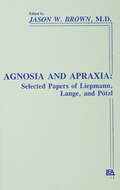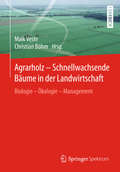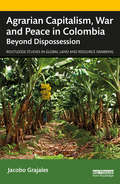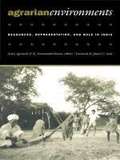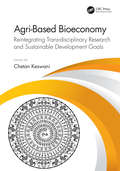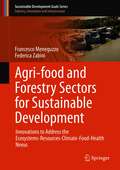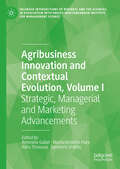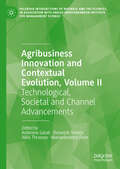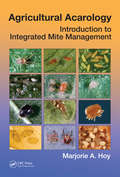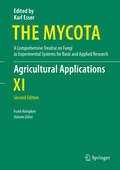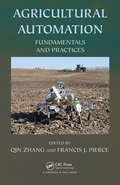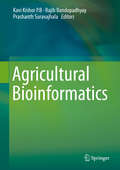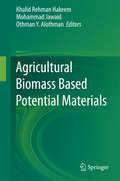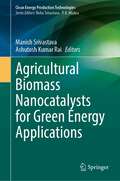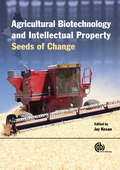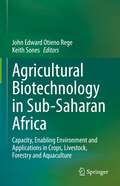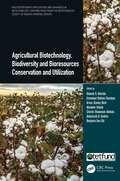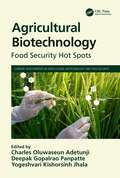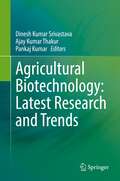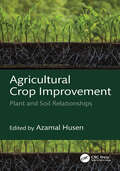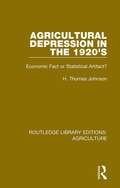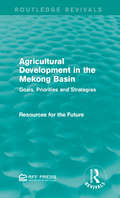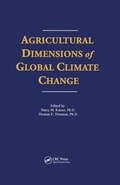- Table View
- List View
Agnosia and Apraxia: Selected Papers of Liepmann, Lange, and Potzl (Institute for Research in Behavioral Neuroscience Series)
by Ellen Perecman Jason W. Brown George Dean Emil Franzen Joachim LuwischFirst Published in 1988. The reader is invited to explore this collection of early German papers and not to analyze the work through a comparison with the present but to approach it with a relaxation of bias that extends a new hearing to old ideas. The reader may be surprised to see how little has changed in the association or callosal theory of apraxia since this review by Liepmann. Of interest is the care with which Liepmann studied his patients and the ingenious anatomical accounts.
Agrarholz – Schnellwachsende Bäume in der Landwirtschaft: Biologie - Ökologie - Management
by Maik Veste Christian BöhmDas Buch bietet eine umfassende aktuelle Zusammenfassung und Bewertung der bisherigen Forschungserfahrungen zum Thema Agrarholz und berücksichtigt sowohl Plantagenwirtschaft als auch agroforstliche Nutzungsformen. Es greift die verschiedenen Aspekte der Etablierung von Agrarholz in der Landwirtschaft aus Sicht der Pflanzenökologie und der Ökosystemforschung auf und diskutiert diese im Kontext mit der Produktivität und dem Agrarholz-Management. Zudem werden auch Aspekte der historischen Landnutzung, der Landschaftsplanung und des praktischen Flächenmanagements behandelt und wesentliche Grundlagen zur Biologie, Genetik, (Landschafts-)Ökologie, und der Nutzung von Agrarholz vermittelt. Zielgruppe sind Studierende und Lehrende der Agrar- und Forstwissenschaften, der (Landschafts)-Ökologie, der Umwelt-, Natur- und Landschaftsplanung, des Umwelt- und Ressourcenschutzes sowie Wissenschaftler, Vertreter von Fachbehörden und -verbänden, Naturschützer, Land- und Forstwirte und Anwender angrenzender Fachbereiche.
Agrarian Capitalism, War and Peace in Colombia: Beyond Dispossession (Routledge Studies in Global Land and Resource Grabbing)
by Jacobo GrajalesBased on extensive research conducted in Colombia since 2009, this book addresses the connection between land grabbing and agrarian capitalism, as well as the unfulfilled promises of peace and justice. While land remains a key resource at the core of many contemporary civil wars, the impact of high-intensity armed violence on the formation of agrarian capitalism is seldom discussed. Drawing on nearly 200 interviews, archival research, and geographical data, this book examines land grabbing and the role of violence in capital with a particular focus on one key actor in the Colombian civil war: paramilitary militias. This book demonstrates how the intricate ties between armed conflict and economy formation are obscured by the widespread belief that violence is a radical form of action, breaking with the normal course of society and disconnected from the legal economy. Under this view, dispossession is perceived as diametrically opposed to capitalist accumulation. This belief is enormously influential in precisely those bureaucratic agencies that are in charge of peacebuilding, both domestically and internationally. However, this narrow view of the relationship between armed violence and capitalism belies the close ties between plunder and lawful profit, and obscures the continuity between violent dispossession and the free market. By the same token, it legitimizes post-war inequality in the name of capitalist development. The book concludes by arguing that the promotion of radical democracy in the government of land and rural development emerges as the only reasonable path for pacifying a violent polity. The book is essential reading for students, scholars, and development aid practitioners interested in land and resource grabbing, agrarian capitalism, civil wars, and conflict resolution.
Agrarian Environments: Resources, Representations, and Rule in India
by David Gilmartin K. Sivaramakrishnan Margaret Mckean Arun Agrawal Peter VandergeestAgrarian Environments questions the dichotomies that have structured earlier analyses of environmental processes in India and offers a new way of looking at the relationship between agrarian transformation and environmental change. The contributors claim that attempts to explain environmental conflicts in terms of the local versus the global, indigenous versus outsiders, women versus men, or the community versus the market or state obscure vital dynamics of mobilization and organization that critically influence thought and policy. Editors Arun Agrawal and K. Sivaramakrishnan claim that rural social change in India cannot be understood without exploring how environmental changes articulate major aspects of agrarian transformations--technological, cultural, and political--in the last two centuries. In order to examine these issues, they have reached beyond the confines of single disciplinary allegiances or methodological loyalties to bring together anthropologists, historians, political scientists, geographers, and environmental scientists who are significantly informed by interdisciplinary research. Drawing on extensive field and archival research, the contributors demonstrate the powerful political implications of blurring the boundaries between dichotomous cultural representations, combine conceptual analyses with specific case studies, and look at why competing powers chose to emphasize particular representations of land use or social relations. By providing a more textured analysis of how categories emerge and change, this work offers the possibility of creating crucial alliances across populations that have historically been assumed to lack mutual goals. Agrarian Environments will be valuable to those in political science, Asian studies, and environmental studies.Contributors. Arun Agrawal, Mark Baker, Molly Chattopadhyaya, Vinay Gidwani, Sumit Guha, Shubhra Gururani, Cecile Jackson, David Ludden, Haripriya Rangan, Paul Robbins, Vasant Saberwal, James C. Scott, K. Sivaramakrishnan, Ajay Skaria, Jennifer Springer, Darren Zook
Agri-Based Bioeconomy: Reintegrating Trans-disciplinary Research and Sustainable Development Goals
by Chetan KeswaniThis volume concentrates on the recent scientific advancements in agricultural biotechnology and reintegrates it with socio-economic, industrial and intellectual property aspects of agricultural biotechnology and its implications for accomplishing the sustainable development goals. Adopting a unique approach, this book amalgamates science and business perspectives from an insider’s viewpoint on the agro-biotech industry, laying the foundations for students and professionals alike. This book: Is a first of its kind by addressing the recent issues emerging in agro-based economies. Will be a single-point source for recent advancements in agro-based global bioeconomy. Empowers the utilization of biotechnology to address worldwide ecological issues by supporting sustainable resolutions for global agricultural markets. Gives both foundational hypothesis and functional direction on commercialization and regulatory issues. Empowers the usage of adaptable approaches that can adjust to and uphold socially and financially valuable agro-based technologies.
Agri-food and Forestry Sectors for Sustainable Development: Innovations to Address the Ecosystems-Resources-Climate-Food-Health Nexus (Sustainable Development Goals Series)
by Francesco Meneguzzo Federica ZabiniThis book surveys state-of-the-art and prospective practices, methods and technologies in agri-food and forestry sectors to document the potential measurable improvements in areas of environmental management, food security, economic growth, social cohesion and human health at the local and global scale. With a focus on the ecosystems-resources-climate-food-health nexus as a framework towards achieving the UN Sustainable Development Goals applicable in these sectors, the book offers a portfolio of guidelines and standards that assesses the affordability, potential profitability and possible unintended consequences of interventions. The areas of intervention covered in the study include global and local forest resources management, safe wastewater reuse for irrigation, sustainable crop and plant protection (e.g. biopesticides, bioherbicides), carbon sequestration and emission reduction strategies, and safe processing methods for food and food waste (e.g. sustainable food preservatives and healthier food). The book is primarily intended for academics, professionals, and policymakers. The professional audience, including enterprises in the forestry, farming, food processing, healthcare and waste management sectors, will take advantage of the updated knowledge basis concerning the innovations in the respective practices, methods and technologies, including their feasibility, affordability and profitability, and policymakers will find useful the comprehensive review of these innovations which could be strategically promoted and deployed in the next decade, with the aim of achieving the UN Sustainable Development Goals.
Agribusiness Innovation and Contextual Evolution, Volume I: Strategic, Managerial and Marketing Advancements (Palgrave Intersections of Business and the Sciences, in association with Gnosis Mediterranean Institute for Management Science)
by Demetris Vrontis Alkis Thrassou Antonino Galati Mariantonietta FioreAgriculture is the oldest and most traditional of economic sectors, and its business has seen major evolutionary leaps over the past century. Contemporary agribusiness is being influenced and reshaped by technological advancements, geopolitical developments, globalisation, transport and logistics innovations, as well as changes in industry structure and consumer behaviour. Reflecting on these changes and providing a deep dive into this sector, this two-volume scientific works’ collection defines, refines, analyses, and prescribes the evolution of agribusiness in the present and future. Taken together, the books offer a comprehensive conceptualisation of the multifactorial macro, micro and organisational elements of agribusiness, including strategic, managerial, marketing, technological and geo-socio-political forces. Volume I explores the strategic, managerial and marketing aspects of contemporary agribusiness, and descriptively and prescriptively investigates the organisational and immediate industry practices and sectoral forces. Topics covered include circular business models, CSR communication practices, digital marketing, organisational sustainability and contemporary farming systems, to name a few..
Agribusiness Innovation and Contextual Evolution, Volume II: Technological, Societal and Channel Advancements (Palgrave Intersections of Business and the Sciences, in association with Gnosis Mediterranean Institute for Management Science)
by Demetris Vrontis Alkis Thrassou Antonino Galati Mariantonietta FioreAgriculture is the oldest and most traditional of economic sectors, and its business has seen major leaps in innovation over the past century. Contemporary agribusiness is being influenced and reshaped by technological developments, geopolitical developments, and globalisation, as well as transport and logistics innovations, changes in consumer behaviour.Reflecting on these changes and providing a deep dive into this sector, this two-volume work defines, refines, analyses, and prescribes the evolution of agribusiness in the present and future. Taken together, the books offer a comprehensive conceptualisation of the multifactorial macro, micro and organisational elements of agribusiness, including strategic, managerial, marketing, technological and geo-socio-political forces.Volume II focuses on the wider, macro-environmental forces acting upon agribusinesses, exploring the contextual evolutions that impact the sector, and the means, practices and avenues for its development.It includes topics such as digital technologies adoption, supply chain sustainability, big data analytics, women’s agricultural entrepreneurship, and simulation model decision making.
Agribusiness Management and Entrepreneurship (Third Edition)
by Michael E. Newman Walter J. WillsAgribusiness Management and Entrepreneurship is intended to fill the need for a basic textbook covering the planning, organizing, and managing of an operation; as well as provide a comprehensive source for those who wish to consider a business from the ownership point of view, specifically as it relates to the vast area of agribusiness.
Agricultural Acarology: Introduction to Integrated Mite Management
by Marjorie A. HoyWritten by a globally prominent entomologist, Agricultural Acarology: Introduction to Integrated Mite Management provides tools for developing integrated mite management programs for agriculture, including management of plant-feeding mites, mites attacking bees and livestock, and stored products. Emphasizing the biology, ecology, behavior, and diverse methods of controlling mites, this book provides an overview of the management of agriculturally important mites using all available Integrated Pest Management (IPM) tools, including biological control, cultural practices, host-plant resistance, and pesticides.Agricultural Acarology prepares agricultural managers to identify, manage, and contribute to the field of integrated mite management. An accompanying downloadable resource contains numerous color photographs of mites and the damage they cause, and PDFs of key publications.
Agricultural Applications (The Mycota #11)
by Frank KempkenThis volume covers the high relevance of fungi for agriculture. It is a completely updated and revised second edition with fourteen excellent chapters by leading scientists in their fields and offers a comprehensive review of the latest achievements and developments. Topics include: Food and fodder; fungal secondary metabolites and detoxification; biology, disease control and management; symbiontic fungi and mycorrhiza; and phytopathogenicity.
Agricultural Automation: Fundamentals and Practices
by Qin Zhang Francis J. PierceAgricultural automation is the core technology for computer-aided agricultural production management and implementation. An integration of equipment, infotronics, and precision farming technologies, it creates viable solutions for challenges facing the food, fiber, feed, and fuel needs of the human race now and into the future. Agricultural Automat
Agricultural Bioinformatics
by Kavi Kishor P.B. Rajib Bandopadhyay Prashanth SuravajhalaA common approach to understanding the functional repertoire of a genome is through functional genomics. With systems biology burgeoning, bioinformatics has grown to a larger extent for plant genomes where several applications in the form of protein-protein interactions (PPI) are used to predict the function of proteins. With plant genes evolutionarily conserved, the science of bioinformatics in agriculture has caught interest with myriad of applications taken from bench side to in silico studies. A multitude of technologies in the form of gene analysis, biochemical pathways and molecular techniques have been exploited to an extent that they consume less time and have been cost-effective to use. As genomes are being sequenced, there is an increased amount of expression data being generated from time to time matching the need to link the expression profiles and phenotypic variation to the underlying genomic variation. This would allow us to identify candidate genes and understand the molecular basis/phenotypic variation of traits. While many bioinformatics methods like expression and whole genome sequence data of organisms in biological databases have been used in plants, we felt a common reference showcasing the reviews for such analysis is wanting. We envisage that this dearth would be facilitated in the form of this Springer book on Agricultural Bioinformatics. We thank all the authors and the publishers Springer, Germany for providing us an opportunity to review the bioinformatics works that the authors have carried in the recent past and hope the readers would find this book attention grabbing.
Agricultural Biomass Based Potential Materials
by Khalid Rehman Hakeem Mohammad Jawaid Othman Y. AlothmanAgricultural biomass is abundant worldwide and it can be considered as alternative source of renewable and sustainable materials which can be used as potential materials for different applications. Despite this enormous production of agricultural biomass, only a small fraction of the total biomass is utilized for different applications. Industry must be prepared to take advantage of the situation and utilize the available biomass in the best possible manner. Agricultural biomass such as natural fibres has been successfully investigated as a great potential to be used as a renewable and sustainable materials for the production of composite materials. Natural fibres offer excellent specific properties and have potential as outstanding reinforcing fillers in the matrix and can be used as an alternative material for biocomposites, hybrid composites, pulp, and paper industries. Natural fibre based polymer composites made of jute, oil palm, flex, hemp, kenaf have a low market cost, attractive with respect to global sustainability and find increasing commercial use in different applications. Agricultural biomass based composites find applications in a number of fields viz. , automotive industry and construction industry. Future research on agricultural biomass-natural fibre based composites should not only be limited to its automotive applications but can be explored for its application in aircraft components, construction industry, rural housing and biomedical applications. In this book we will cover the chemical, physical, thermal, electrical, and biodegradability properties of agricultural biomass based composite materials and its different potential applications. The main goal of this volume is to familiarize researchers, scientists and engineers with the unique research opportunities and potentials of agricultural biomass based materials. Up-to-date information on alternative biomass utilization Academic and industry leaders discuss unique properties of biomass based composite materials Direct application of agricultural biomass materials as sustainable and renewable alternatives
Agricultural Biomass Nanocatalysts for Green Energy Applications (Clean Energy Production Technologies)
by Manish Srivastava Ashutosh Kumar RaiThe book discusses the various sustainable approaches to combine agrowaste and nanomaterials into catalysts or nanocatalysts with the objective of enhancing biofuel production. It explores the practical sustainability of agronanocatalysts in bioenergy production at a mass scale, while also addressing the existing challenges and proposes sustainable remedies to overcome these limitations. Additionally, the book dives into the cost considerations, recognizing it as a major concern for the widespread utility of catalysts, and explores viable commercial applications in this context.Nanomaterials continue to attract attention in the field of proteins and enzymes due to their versatile physicochemical properties and potential. They offer opportunities to enhance various biofuel production processes by serving as catalysts in the reaction medium. For instance, studies have highlighted the significant improvements in cellulase enzyme production, stability, pretreatment of lignocellulosic biomass, and enzymatic hydrolysis efficiency achieved through the utilization of nanomaterials. The impact of nanomaterials on fermentative hydrogen production has also been documented. While the application of nanomaterials in biofuel production processes has been reported in the literature, there remains a need to focus on the type of nanomaterials, their synthesis, and their specific effects on important process parameters. Addressing and evaluating these factors is crucial to effectively improve and streamline biofuel production processes using nanomaterials. The book serves as a comprehensive introduction to nanomaterials and nanotechnology in biofuel production, catering to the needs of researchers, academicians and students.
Agricultural Biotechnology and Intellectual Property: Seeds of Change
by Jay P. KesanThis volume addresses the intersection of agricultural biotechnology with intellectual property rights (IPRs) from a number of diverse perspectives.
Agricultural Biotechnology in Sub-Saharan Africa: Capacity, Enabling Environment and Applications in Crops, Livestock, Forestry and Aquaculture
by John Edward Otieno Rege Keith SonesThis book offers a comprehensive analysis of the application level for various agricultural biotechnologies across Sub-Saharan Africa. The authors examine the capacity available as well as the enabling environment, including policy and investments, for facilitating agricultural biotechnology development and use in the region. For each Sub-Saharan country, the status of biotechnology application is assessed in four major sectors; Crops, Livestock, Forestry and Aquaculture. Examples such as the number and requisite skill levels of trained personnel, biosafety frameworks and public awareness are surfaced in these chapters. This work also discusses the impact of push-pull factors on research, training and food security and identifies opportunities for investment in biotechnology and local agribusiness.Development partners, policy makers, agricultural consultants as well as scientists and private sector investors with an interest in biotechnology initiatives in Sub-Saharan Africa will find this collection an important account to identify key gaps in capacity and policy, as well as priority areas going forward. The volume highlights ways to develop technology and increase agricultural production capacity through international cooperation and inclusive economic growth, making it a valuable practice guide in line with the UN Sustainable Development Goals, in particular SDG 2 Zero Hunger and SDG 8 Decent Work and Economic Growth. Clear case studies round off the reading experience.
Agricultural Biotechnology, Biodiversity and Bioresources Conservation and Utilization (Multidisciplinary Applications and Advances in Biotechnology)
by Charles Oluwaseun Adetunji Abdulrazak B. Ibrahim Benjamin Ewa Ubi Olawole O. Obembe Abubakar Gidado Emmanuel Olufemi Ekundayo Arinze Stanley OkoliThis book covers a range of important topics on crop and animal genetics, breeding and genomics, as well as biodiversity and genetic resources conservation and utilization reflecting three thematic sections of working groups of the Biotechnology Society of Nigeria. The topics range from agricultural biotechnology, including genetically modified organisms and gene-editing for agronomically important traits in tropical crops, to Nigeria’s mega biodiversity and genetic resources conservation. This book will engender a deeper understanding of underpinning mechanisms, technologies, processes and science–policy nexus that has placed Nigeria as a leader in biotechnology in Africa. The book will be useful reference material for scientists and researchers working in the fields of food and agricultural biotechnology, bioinformatics, plant and animal genetics, breeding and genomics, genetic resources conservation and enhancement. Emphasizes recent advances in biotechnologies that could ameliorate the high-level global food and nutrition insecurity through plant and animal genetics, breeding, as well as genomics Provides detailed information towards harnessing indigenous bioresources for food and nutrition security and climate change adaptation Introduces new frontiers in the area of genomics, most especially their relevant applications in crop and animal breeding Reviews biotechniques that could enhance plant genetic resources conservation and utilization Discusses current biotechnological approaches to exploit genetic resources including the development of synthetic hexaploid wheat (SHW) for crop adaptation to the increasingly changing global climate
Agricultural Biotechnology: Food Security Hot Spots (Current Developments in Agricultural Biotechnology and Food Security)
by Charles Oluwaseun Adetunji Deepak Gopalrao Panpatte Yogeshvari Kishorsinh JhalaThis book presents strategies and techniques highlighting the sustainability and application of microbial and agricultural biotechnologies to ensure food production and security. This book includes different aspects of applications of Artificial Intelligence in agricultural systems, genetic engineering, human health and climate change, recombinant DNA technology, metabolic engineering and so forth. Post-harvest extension of food commodities, environmental detoxification, proteomics, metabolomics, genomics, bioinformatics and metagenomic analysis are discussed as well. Features: Reviews technological advances in microbial biotechnology for sustainable agriculture using Artificial Intelligence and molecular biology approach. Provides information on the fusion between microbial biotechnology and agriculture. Specifies the influence of climate changes on livestock, agriculture and environment. Discusses sustainable agriculture for food security and poverty alleviation. Explores current biotechnology advances in food and agriculture sectors for sustainable crop production. This book is aimed at researchers and graduate students in agriculture, food engineering, metabolic engineering and bioengineering.
Agricultural Biotechnology: Latest Research and Trends
by Pankaj Kumar Ajay Kumar Thakur Dinesh Kumar SrivastavaThis book caters to the need of researchers working in the ever-evolving field of agricultural biotechnology. It discusses and provides in-depth information about latest advancements happening in this field. The book discusses evolution of plant tissue culture techniques, development of doubled haploids technology, role of recombinant-DNA technology in crop improvement. It also provides an insight into the global status of genetically modified crops, use of RNAi technology and mi-RNAs in plant improvement. Chapters are also dedicated for different branches of ‘omics’ science including genomics, bioinformatics, proteomics, metabolomics and phenomics along with the use of molecular markers in tagging and mapping of various genes/QTLs of agronomic importance. This book also covers the role of enzymes and microbes in agriculture in productivity enhancement. It is of interest to teachers, researchers of biotechnology and agriculture scientists. Also the book serves as additional reading material for undergraduate and postgraduate students of biotechnology, agriculture, horticulture, forestry, ecology, soil science, and environmental sciences. National and international biotechnologists and agricultural scientists will also find this to be a useful read.
Agricultural Crop Improvement: Plant and Soil Relationships (Exploring Medicinal Plants)
by Azamal HusenLarger amounts of nutritious food are required to feed the growing world population, which is a great challenge due to water shortages and reduced crop plant yield. To overcome this issue, there must be improvement in crop plant production systems. Agricultural Crop Improvement: Plant and Soil Relationships addresses key issues of crop plant yield and production, with molecular and physiological interventions to evolve future strategies that will overcome these challenges faced by the agricultural sector.Features Investigates modern and traditional agricultural techniques, including nanomaterials, nanosensors, genetic engineering, molecular breeding, nutrient and plant hormone interactions, microbiome engineering, soil enzymes, biostimulants, and intercropping Explores how technologies and scientific advancements from biotechnology, information technology, and environmental science are revolutionizing sustainable farming practices Agricultural Crop Improvement: Plant and Soil Relationships is a valuable source of information for researchers and extension workers involved in sustainable crop plants improvement and practices, and a useful resource for students and scientists working on aspects of agriculture, botany, plant science, crop physiology, crop biotechnology, and microbiology.
Agricultural Depression in the 1920's: Economic Fact or Statistical Artifact? (Routledge Library Editions: Agriculture #1)
by Thomas H. JohnsonFirst published in 1985. This study explores the agricultural depression in the United States of America in the 1920’s. The author examines overproduction, wartime optimism and the farm crisis, and continuity and change in agriculture during this period. This title will be of great interest to students of history, agriculture, and economics.
Agricultural Development in the Mekong Basin: Goals, Priorities and Strategies (Routledge Revivals)
by Resources for the FutureOriginally written for the International Bank for Reconstruction and Development, Resources for the future published this report in 1971 believing it would be of interest to more general readers. Resources for the Future draws on its past experience of resource utilization, development and economics to comment on issues faced by the Mekong Basin River for agricultural development such as the demand-supply conditions for improved agriculture, the limitations imposed by physical and human resource conditions and measures needed to modernize their agricultural methods. This title will be of interest to students of Environmental and Economic studies.
Agricultural Dimensions of Global Climate Change
by Harry Kaiser Thomas DrennenThis important book, written by recognized leaders in their fields, discusses agricultural dimensions of global climate change. Research and policy issues are covered and a multidisciplinary view of global climate change and agriculture is presented. Major sections cover the contribution of agriculture to greenhouse gas (GHG) emissions (including an investigation as to whether monitoring and verification of such emissions would work) and the impact of global climate change on agriculture. The book examines such important issues as global food availability, distributional effects between developing and developed countries, agricultural adaptation possibilities, and whether CO2 enrichment will benefit agriculture. A unique feature of this publication is that it addresses communication difficulties between researchers and policy makers and suggests solutions.
